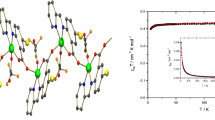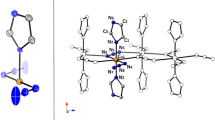Abstract
Using Bu4N[Fe(Tp*)(CN)3]− (Tp* = hydrotris(3,5-dimethylpyrazol-1-yl)borate) as the building block to react with CuII and N-methylimidazole, we obtained a one-dimensional (1D) heterobimetallic cyano-bridged chain, [Fe(Tp*)(CN)3]2Cu(N-methylimidazole)2·2H2O (1). The crystal structures and magnetic studies demonstrate that complex 1 exhibits slow relaxation of the magnetization due to strong intrachain ferromagnetic coupling and weak interchain interactions.
Similar content being viewed by others
References
Sato O, Iyoda T, Fujishima A, Hashimoto K. Photoinduced magnetization of a cobalt-iron cyanide. Science, 1996, 272: 704–705
Sato O, Iyoda T, Fujishima A, Hashimoto K. Electrochemically tunable magnetic phase transition in a high-T c chromium cyanide thin film. Science, 1996, 271: 49–51
Ohkoshi S, Ikeda S, Hozumi T, Kashiwagi T, Hashimoto K. Photoinduced magnetization with a high curie temperature and a large coercive field in a cyano-bridged cobalt tungstate bimetallic assembly. J Am Chem Soc, 2006, 128: 5320–5321
Ohkoshi S, Imoto K, Tsunobuchi Y, Takano S, Tokoro H. Light-induced spin-crossover magnet. Nat Chem, 2011, 3: 564–569
Bousseksou A, Molnár G, Salmon L, Nicolazzi W. Molecular spin crossover phenomenon: recent achievements and prospects. Chem Soc Rev, 2011, 40: 3313–3335
Wang XY, Wang ZM, Gao S. Constructing magnetic molecular solids by employing three-atom ligands as bridges. Chem Commun, 2008, 281–294
Weng DF, Wang ZM, Gao S. Framework-structured weak ferromagnets. Chem Soc Rev, 2011, 40: 3157–3181
Sun H.L, Wang ZM, Gao S. Strategies towards single-chain magnets. Coord Chem Rev, 2010, 254: 1081–1100
Cornia A, Mannini M, Sainctavit P, Sessoli R. Chemical strategies and characterization tools for the organization of single molecule magnets on surfaces. Chem Soc Rev, 2011, 40: 3076–3091
Rinehart JD, Long JR. Exploiting single-ion anisotropy in the design of f-element singlemolecule magnets. Chem Sci, 2011, 2: 2078–2085
Kahn O, Martinez CJ. Spin-transition polymers: from molecular materials toward memory devices. Science, 1998, 279: 44–48
Myers EB, Ralph DC, Katine JA, Louie RN, Current-induced switching of domains in magnetic multilayer devices. Science, 1999, 285: 867–870
Troiani F, Affronte M. Molecular spins for quantum information technologies. Chem Soc Rev, 2011, 40: 3119–3129
Sanvito S. Molecular spintronics. Chem Soc Rev, 2011, 40: 3336–3355
Bai YL, Tao J, Wernsdorfer W, Sato O, Huang RB, Zheng LS. Coexistence of magnetization relaxation and dielectric relaxation in a single-chain magnet. J Am Chem Soc, 2006, 128: 16428–16429
Liu T, Zhang YJ, Kanegawa S, Sato O. Photoinduced metal-to-metal charge transfer toward single-chain magnet. J Am Chem Soc, 2010, 132: 8250–8251
Miyasaka H, Julve M, Yamashita M, Clérac R. Slow Dynamics of the magnetization in one-dimensional coordination polymers: singlechain magnets. Inorg Chem, 2009, 48: 3420–3437
Harris TD, Bennett MV, Clérac R, Long JR. [ReCl4(CN)2]2: A high magnetic anisotropy building unit giving rise to the single-chain magnets (DMF)4MReCl4(CN)2 (M = Mn, Fe, Co, Ni). J Am Chem Soc, 2010, 132: 3980–3988
Toma LM, Lescouëzec R, Pasán J, Ruiz-Pérez C, Vaissermann J, Cano J, Carrasco R, Wernsdorfer W, Lloret F, Julve M. [Fe(bpym) (CN)4]: A new building block for designing single-chain magnets. J Am Chem Soc, 2006, 128: 4842–4853
Liu T, Zhang YJ, Kanegawa S, Sato O. Water-switching of spin transitions induced by metal-to-metal charge transfer in a microporous framework. Angew Chem Int Ed, 2010, 49: 8645–8648
Zhang YJ, Liu T, Kanegawa S, Sato O. Reversible single-crystal-to-single-crystal transformation from achiral antiferromagnetic hexanuclears to a chiral ferrimagnetic double zigzag chain. J Am Chem Soc, 2009, 131: 7942–7943
Zhang YJ, Liu T, Kanegawa S, Sato O. Interconversion between a nonporous nanocluster and a microporous coordination polymer showing selective gas adsorption. J Am Chem Soc, 2010, 132: 912–913
Jiang L, Feng XL, Lu TB, Gao S. Synthesis, structures, and magnetic properties of a series of cyano-bridged Fe-Mn bimetallic complexes. Inorg Chem, 2006, 45: 5018–5026
Wen HR, Wang CF, Song Y, Gao S, Zuo JL, You XZ. Synthesis, crystal structures, and magnetic properties of cyano-bridged heterobimetallic chains based on [(Tp)Fe(CN)3]−. Inorg Chem, 2006, 45: 8942–8949
Wang S, Zuo JL, Gao S, Song Y, Zhou HC, Zhang YZ, You XZ. The observation of superparamagnetic behavior in molecular nanowires. J Am Chem Soc, 2004, 126: 8900–8901
Wang S, Ding XH, Zuo JL, You XZ, Huang W. Tricyanometalate molecular chemistry: A type of versatile building blocks for the construction of cyano-bridged molecular architectures. Coord Chem Rev, 2011, 255: 1713–1732
Gu ZG, Liu W, Yang QF, Zhou XH, Zuo JL, You XZ. Cyanobridged FeIII 2CuII 3 and FeIII 4NiII 4 complexes: Syntheses, structures, and magnetic properties. Inorg Chem, 2007, 46: 3236–3244
Sheldrick GM. SHELXL-97: Program for refinement of crystal structures. University of Göttingen, Göttingen, Germany, 1997
Wang S, Zuo JL, Zhou HC, Choi HJ, Ke Y, Long JR, You XZ. [(Tp)8(H2O)6CuII 6FeIII 8(CN)24]4+: A cyanide-bridged face-centeredcubic cluster with single-molecule-magnet behavior. Angew Chem Int Ed, 2004, 43: 5940–5943
Author information
Authors and Affiliations
Corresponding authors
Electronic supplementary material
Rights and permissions
About this article
Cite this article
Dong, D., Zheng, H., Zhao, L. et al. Synthesis, structure, and magnetic properties of a cyanidebridged Fe(III)-Cu(II) bimetallic double-zigzag chain with slow relaxation of the magnetization. Sci. China Chem. 55, 1018–1021 (2012). https://doi.org/10.1007/s11426-012-4597-7
Received:
Accepted:
Published:
Issue Date:
DOI: https://doi.org/10.1007/s11426-012-4597-7




